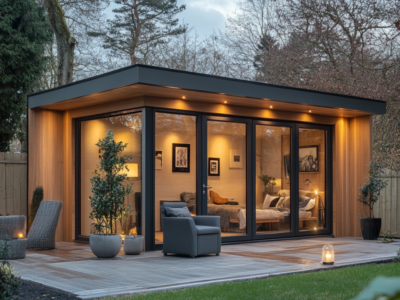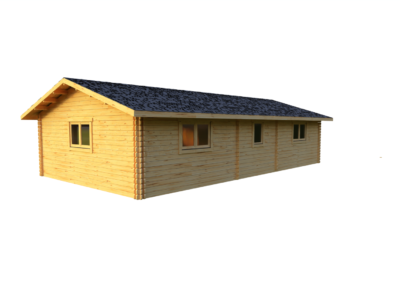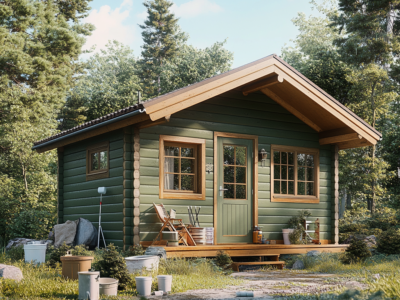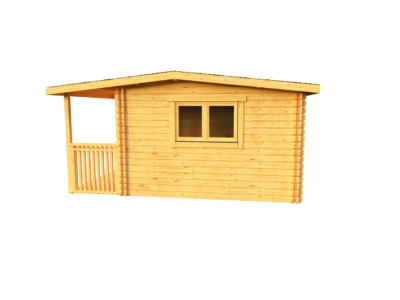Ventilation i trækonstruktioner som haveskure, bjælkehytter eller andre opbevaringskonstruktioner er afgørende for at forhindre ophobning af fugt og fremme luftgennemstrømningen, samtidig med at man beskytter sig mod mug, skimmel og andre organismer, der potentielt kan skade materialer og...
Wooden garden buildings make natural or passive ventilation simple to achieve, with no extra vents usually being necessary for ventilation purposes.
Keep the Doors and Windows Open
If you don’t want your garden building to become overheated in summer and subfreezing cold in winter, proper ventilation should always be maintained by opening doors and windows when ventilation is required. This allows air circulation and the removal of moisture accumulated inside, helping prevent the shed or log cabin becoming damp and decayed over time.
Your garden building could become uncomfortable to work in and even lead to structural rot that requires its demolition and reconstruction – potentially at great expense and at risk of ruining equipment or tools stored within.
Ventilation is also key in order to prevent condensation from forming on the walls and window frames of your garden building, which can damage wood surfaces and cause peeling paint. Excess moisture not only harms its aesthetic appeal, but can lead to mould and mildew growth that’s unpleasant as well as unhealthy for residents in your home.
One of the easiest and cost-effective ways to ventilate a garden room is simply leaving its doors and windows open. This method works best on warm and sunny days when air circulation carries away moisture more readily, but can still provide benefit even on dull or rainy days.
However, it is essential to keep in mind that opening windows could pose a safety or health risk (for instance if there are small children present who could fall out the window or if you suffer from asthma or other respiratory conditions). Furthermore, virus particles infiltrating into Havebygninger from outside could spread germs that lead to illness and poor health conditions.
If you don’t wish to keep the windows open at all times, you can improve ventilation in your garden building by installing mechanical systems or by adding additional ventilation methods – static vents, whirligigs and dehumidifiers can all contribute towards keeping it healthy and functional for years to come.
Install Static Vents
Ventilation is key when it comes to garden buildings as it prevents mould growth and unpleasant odours, regulates temperature levels, protects wooden materials from excessive moisture exposure and keeps condensation off windows – something condensation causes, which in turn leads to mould growth that damages glass windows as well as creating sticky sticky textures that are difficult to remove. When ventilation is in place, buildings become more comfortable places for people to spend time inside without condensation forming on windows that cause condensation issues that lead to mould and mildew growth resulting in damaged glass damage as well as avoidance of condensation forming on windows – thus making spending time spent inside more enjoyable without condensation forming on windows caused by condensation forming on windows due to condensation forming on windows – an issue caused by condensation forming on windows which causes condensation issues in terms of protecting wooden materials against excess moisture resulting from excess moisture causing mould growth as well as producing an unpleasant sticky substance which makes cleaning it off easier!
To address this, there are various strategies for encouraging passive ventilation in your garden room. One option is opening windows slightly so air can circulate naturally. Trickle vents installed above windows also offer steady airflow without creating drafts – making these ideal for garden rooms such as workshops that utilise paints and solvents.
For larger garden rooms, installing gable or wall vents that will let fresh air through is optimal. These vents work by taking advantage of buoyancy – which refers to warm and moist air’s tendency to rise – pushing outward from your home and out of your garden room. This simple yet effective strategy keeps air flowing freely in and can even be combined with a whirligig to increase air movement.
A whirligig acts like a roof fan when installed at the triangular end of a garden building (gable). It draws wind in, propelling it through, and drawing out any stagnant air that might accumulate inside, thus purifying stale air from within the shed or cabin. These devices make an excellent addition to large garden rooms when combined with static vents on its walls for even better air purification.
An electric or solar fan can also provide passive ventilation. As this simple solution can be switched on whenever necessary, passive ventilation becomes more achievable than ever. Keep in mind it’s essential to achieve an appropriate balance between intake and exhaust ventilation; always err towards having more intake ventilation than exhaust ventilation.
Add a Whirligig
Simplest way to ventilate a shed, log cabin or garden room: keep its windows and doors open! This allows airflow through the structure, carrying away moisture that may have collected during damp periods – keeping your space cool and fresh!
Garden rooms, log cabins and sheds with gable end or pent roofs can benefit from installing ridge vents at their peaks to increase ventilation. Crafted of tough yet opaque plastic materials, these vents allow air circulation while venting fumes from paint or petrol fumes outside and have an anti-creepy crawly grille to keep out any creepy crawlies. While ridge vents work best during sunny weather conditions they can also be combined with whirligigs to create drafts.
Gable wall-mounted static vents can help improve passive ventilation by allowing airflow throughout a building. They can be combined with either a whirligig or solar-powered electric fan for enhanced effectiveness; when coupled, this combination pushes drier air from inside into cabins via gable vents for greater airflow.
If your shed, cabin or garden room is large and you plan on using it as a workshop, active ventilation may not be sufficient for preventing mould and mildew growth. A dehumidifier could be the ideal investment at this point as its powerful suctions remove excess moisture from the air to lower humidity and help avoid mould and mildew growth.
Proper ventilation is crucial to creating an enjoyable, healthy and functional shed, cabin or garden room environment. By planning ahead for ventilation needs in advance, you can enjoy your shed for years to come! To discover more of the various ventilation options available to you, take a look at Waltons’ garden buildings how-to guides or consult one of our helpful guides and advice pages or how-to guides – by doing so effectively, your garden room will remain functional year round and will serve you well for years!
Use a Dehumidifier
If your garden shed serves as a workshop, office, or craft space, proper ventilation is absolutely crucial for optimal functioning. Without it, air can become stagnant and musty quickly; items within are vulnerable to mould and mildew growth; excessive moisture in the air may affect plant growth or even cause structural rot in timber structures.
Proper ventilation allows humidity to leave a building and fresh air to enter, helping maintain an appropriate temperature balance and keeping everything dry – this prevents temperature swings between summer and winter, prolonging its lifespan.
There are various methods you can employ to ensure your shed is properly ventilated, from passive methods such as leaving windows open, through to more elaborate mechanical systems like vents or fans. Ventilation should be carefully considered during design stage of building to ensure it works with proper insulation for maximum effect.
Dehumidifiers are an ideal way to maintain an acceptable humidity level in your garden room or log cabin when temperatures become warm and dry. By extracting moisture from the air, dehumidifiers work by extracting any extra humidity that exists and can either run continuously or on demand depending on your requirements – or can even be connected directly to a duct system for ease of control over moisture flow outside.
Dehumidifiers can be noisy and require regular maintenance, but are an effective solution when it comes to controlling humidity in your garden shed or log cabin. If you decide to purchase one, make sure that it’s a whole-home model rather than portable device as these have larger capacities to extract more moisture from the air.
Overall, proper ventilation is a critical element to maintaining an enjoyable garden shed or log cabin throughout the year. By following these tips, your garden building will remain free from moisture that could lead to damage and rot – prolonging its life as a long-term investment.






